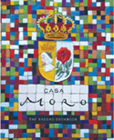
UK/Ireland
•Canada/USA
________________________________________________________________________

eat
oranges
Oranges provide seasonal
eaters with a taste of sun in the middle of winter. Apart from forming
an integral component in an unlimited number of delicious juices, oranges
can be utilized in sauces for savory dishes and in fabulous desserts (see
PICK OF THE RECIPES) where they form a heavenly match with chocolate.
HISTORY
Oranges are thought to have their origin in a sour fruit growing wild in the region of South West China and North East India as early as 2,500 BC. For thousands of years these bitter oranges were used mainly for their scent, rather than their eating qualities.
The Romans brought the fruit to Europe and later oranges were spread to Spain by the Moorish conquests in the eight and ninth centuries. The sweet orange familiar to us today probably developed somewhat later.
The fruit arrived in Central America with Columbus in 1493 and soon afterwards the Portuguese introduced them to Brazil.
Oranges are now an important crop in warm climates around the world, most notably Brazil, USA, Spain, North and South Africa, Israel and Australia.
BIOLOGY
Orange trees are semi-tropical non-deciduous trees of the genus Citrus. The fruit is a type of berry and sweet oranges belong to the species Citrus sinensis (the bitter Seville oranges are C. aurantium).
NUTRITION
Oranges are an excellent source of vitamin C, but when the flesh or juice is exposed to air the vitamin content depletes fairly rapidly. Folate and hesperidin (a flavonoid with antioxidant properties) are also present.
TIPS
BUYING
Choose oranges that are firm and feel heavy (weightier oranges are juicier).
Very large fruit can sometimes be less sweet and concentrated in flavor.
Skin color is not indicative of quality - untreated ripe oranges are
often pale orange or greenish but those sold in supermarkets may be treated
with ethylene (to break down the green chlorophyll) and then colored
with orange dye.
The vast majority of commercial oranges (Sevilles apart) are treated with a wax polish that may have deleterious effects. If using the rind, try to find unwaxed (and ideally organic) oranges.
Some oranges sold can be a little dry, pithy or lacking in flavor. Navel oranges (identifiable by the belly button-like rudimentary fruit growth at one end) from Spain are consistently of high quality, and are also seedless and easy to peel. Valencias, at their best, are perfect for juicing. Jaffa oranges are another excellent choice.
STORING
Oranges in the shops today may have been picked anything from a few days
to a few weeks earlier. Most will keep for a couple of weeks at room temperature.
PREPARING
If juicing, roll on a flat surface first to set loose the juice. If using
the zest, scrub the skin thoroughly and avoid cutting or grating too deeply
- the bitter white pith is best avoided.
OTHER STUFF
The color orange was named after the fruit, not vice-versa. The word orange comes from the Sanskrit naranga meaning fragrant.
PICK OF THE RECIPES
in
season:
january
february
march
april
may
june
july
august
september
october
november
december
main regions:
Florida, California
ONLINE
IN PRINT
-
Pan Fried John Dory with an Orange and Hazelnut Salad
The Complete Cookery Year -
Pistachio and Almond Tart with Orange and Cardamom
Casa Moro

